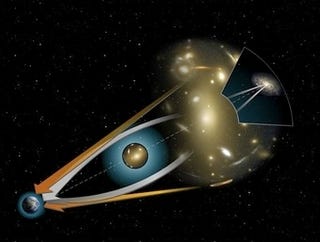"There are circumstances under which masering is possible in the solar atmosphere. These do not involve energy changes inside atoms but are do do with electron/magnetic field resonances.
On occasion we see short-lived, very intense, narrow-band and highly-circularly polarized bursts from solar flares. These are widely believed to be due to “electron/cyclotron masering”.
The picture starts off with a solar flare, which produces a population of high-energy, relativistic electrons. Some of these find their way into a bipolar magnetic loop, with both ends rooted in the photosphere. The electrons execute trapped motion, bouncing between the ends of the loop, where the structure tapers and the magnetic field strength increases.
If these particles have initially a wide distribution of pitch angles, those with high pitch angles (with a larger velocity component along the magnetic field lines) will tend to penetrate further down the throat of the loop, where the density of ambient plasma is higher. There they have a much higher probability of hitting something. They get thermalized and scattered, so that after a few bounces the pitch angle distribution has a deficit of high pitch angle electrons; there are conical holes (loss cones) in the distribution. If the electron distribution is a high-energy beam, the pitch angle distribution of the electrons in the loop will not be initially isotropic. It can have a deficit of low-pitch angle electrons. After a few reflections and a loss cone has developed, the electron pitch angle distribution can become interesting. If the initial pitch angles are high enough, all the electrons will get deep enough in the solar atmosphere for them to be thermalized by collisions. This electron bombardment of that dense plasma makes X-rays we can detect as X-ray bursts. However, if part of the pitch angle distribution lies outside the loss cone we may end up with a narrow distribution of electron pitch angles right up against the loss-cone boundary.
The electrons are spiralling around the field lines at the cyclotron (or gyro frequency). A radio wave emitted at the cyclotron frequency can be amplified as it propagates. I tend to retreat into mathematics because some of this is hard to picture, especially in the relativistic case. If you look at the equation for the absorption coefficient for radio waves going through a plasma, and plug in the sorts of conditions mentioned here, the absorption coefficient can be negative. That is, the waves are amplified as they pass through the plasma rather than attenuated. This is masering. However, this does not work for the fundamental frequency. Attenuation at the gyrofrequency is huge, due to other resonances, but not for the third or so harmonic. This still gets amplified and because it has a frequency well above the plasma or other frequencies at which the plasma has high attenuation, it radiates off into space and to Earth, where we can detect them.
If one wanted to produce these emissions on demand, one could do this by providing the high-energy electrons. A modulated stream of electrons could be used, since the emission damps very quickly due to energy loss by those electrons. However, this means we are modulating the power supply, which we have to provide. Alternatively, launching sausage or torsional wave modes in the flux tubes making up the loop would modulate the pitch angle, thus modulating the loss-cones. However, the modulation rate would then have to be low, because to the time these waves require to move to and fro in the loop. Sausage waves would be best because they damp rapidly.
It is true that masering provides an efficient amplification process, but in the solar case, the powering and modulation process would be hard to do efficiently. Since the mirroring depends essentially on the tapering of the magnetic loop, the cyclotron frequency varies along the tube, so the resonance conditions for waves at a given frequency will be met in only a small part of it.
There is another process that might be more interesting. It is less efficient but easier to drive from a low-energy source.
Once again we have a loop filled with high-energy electrons produced by a flare. In this case rather than producing synchrotron emission, they generate plasma oscillations. Imagine the electron being a surfer, but in this case he enters the scenario with high energy, which he give to the wave and not vice versa. Plasma waves fill the tube.
Plasma waves are not radio waves. You need some sort of mode conversion process to transform them. Much of the solar radio emission we observe is due to scattering of these waves off thermal ions, which is very low efficiency. However, if we launch whistlers (electron cyclotron waves ) along the field lines, they pass through a zone where they resonate with the plasma waves, converting them to radio waves with high efficiency. More over, they get past the problem that radio waves with a frequency equal to the plasma frequency cannot propagate. The whistlers act like a mixer, producing radio emissions at the plasma frequency minus the whistler frequency and at the plasma frequency plus the whistler frequency. The former cannot propagate and that sideband is suppressed, feeding its energy back into the conversion process and the upper sideband. Because this is at a frequency above the plasma frequency, it propagates off into space.
The really strong metre-wavelength bursts observed in solar noise storms might be produced by this process. They are intense, short-lived, narrow band, polarized, and that fits the bill.
An active region could be pumping electrons into such a magnetic loop for days.
Getting close enough to drive the whistler production could be a challenge. A pulsed particle accelerator could do it, or nuclear devices exploded in the right place."
 |
Click here to Reply to all, Reply, or Forward
|
